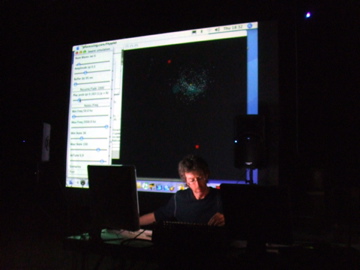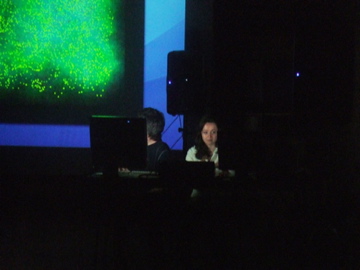Swarm and Attractors: swarmalism
In this work, a large swarm of one hundred particles moves through a number of three-dimensional interpretative spaces. The spaces serve to relate the twisting, swirling swarm to the accompanying melody, rhythm, harmony and spatial location of sound.
Each space is a single musical interpretation of particle position (previous swarm musics have imposed interpretative parameters along the axes of a single space): a spherically symmetric space with concentric shells of increasing pitch, a cellular harmony space spanned by seconds, minor thirds and fifths, a rhythmic space with vast diagonal slabs of silence and an actual positional space that relates each particle location to a place in the room.
This work of swarm minimalism (swarmalism) uses almost the simplest possible materials; triangular waveforms, mathematically exact tempi and diatonic scales and harmonies. The rules governing particle motion are also very parsimonious: if you can see another particle, or an attractor, move closer, but don't bump into anyone else. Despite this simplicity, the motion of the swarm is extremely complex. This motion, manifest as eddies, vortices, oscillations, bifurcations and other patterns, subtly modulates the wave streams (one for each particle) and the music is heard as detailed variations of a number of 'cases'.
Each case, which is a particular instance of the underlying interpretations, represents a compositional scenario, for example
case 0:
setRadiusOfAvoidance(2.0);
speed = 5.0;
setSpeedInPPF(speed);
numWaves = 6;
buffSizeMillis = 95;
if(myStream != null)
setBuffSizeMillis(buffSizeMillis);
setFPS(80);
setScale(MAJOR);
minNote = 36;
maxNote = 100;
setDeTune(true);
break;
The animation consists of a few elements: particles, attractors and the Queen. Attractors can be likened to food; particles congregate around an attractor until the attractor is consumed and vanishes. The swarm is then forced to search elsewhere. New attractors will be automatically placed at locations previously visited by a particle in the swarm.
In the screenshots on the left, particles are coloured green when they bound to an attractor (red dot); otherwise they are white. Blue flashes correspond to particles that have just been sonified. The Queen is positioned at the heart of the swarm and is coloured brown. The screenshots show time-lapse views of the swarm. The particles produce faint trails that appear as fluffy bundles of thread. The solitary motion of the Queen is clearly visible.
Attractor trails can also be added by external interaction, enticing the swarm into other, distant regions of space. The Queen lies at the geometric centre of the swarm, and her slow progress through harmony space determines key. The three dimensional positional space is divided into a number of regions and then mapped to the multi-channel system so that the listener can identify the position of the particle and hence of the corresponding modulation with a point in actual space. Swarm and Attractors is generated in real time and is conducted by an operator who is able to adjust particle speed, visibility of neighbouring particles and other algorithm parameters. The conductor can add attractor trails, choose a particular case and alter characteristics of the projection.
Performances
- Cheltenham Science Festival, 9th June 2007
- Shunt, London Bridge, 21st June 2007 (photos to the left)
- Miso Musicá Viva Festival, Instituto Franco-Português, Lisbon 12th September 2007
- Shunt, London Bridge, with Thanos Chrysakis, June 5th 2008

